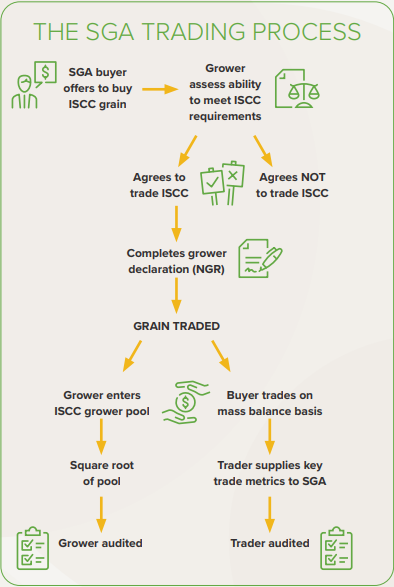Trader Requirements
Becoming Certified as a Trader
A quick guide for Traders intending to trade ISCC certified grain under ISCC


ISCC Trader with warehouse audit checklist
This guideline outlines the ISCC requirements for traders with one or more warehouses to prepare for their initial accreditation audit and is based on the ISCC Chain of Custody Checklist, the document checklist and in addition the RED II Chain of Custody Checklist (ISCC EU only).
It must be read in conjunction with the complete ISCC requirements and System Documents located on the ISCC website to ensure that all the requirements for the ISCC EU and ISCC Plus standards are met.
Warehouse/storage requirements
This is applicable for Traders with storage.
This guideline outlines the ISCC requirements for traders with one or more warehouses to prepare for their initial accreditation audit and is based on the ISCC Chain of Custody Checklist, the document checklist and in addition the RED II Chain of Custody Checklist (ISCC EU only).
It must be read in conjunction with the complete ISCC requirements and System Documents located on the ISCC website to ensure that all the requirements for the ISCC EU and ISCC Plus standards are met.
1. Warehouse(s) used
1st Year – List the company name, contact person, physical address, grain type stores, phone number and email address of one warehouse that will be used to store sustainable grain. 2nd and subsequent Years – List the company name, contact person, physical address, grain type stores, phone number and email address of one warehouses that have were used to store sustainable grain in the previous crop year.2. Warehouse(s) details
Provide the following:- Plan/Layout. Can be a google earth over view picture.
- Storage capacity.
- Storage and handling agreement or operating licence or proof of ownership.
- Weighbridge calibration certificates
3. Inventory Movements
Have written procedures and systems that show how inwards and outwards movements are tracked and recorded so that the quantity of sustainable grain in stock can be determined.Inwards movements
4. List of suppliers
1st Year – Due to timing, as there have been no deliveries from the trade or growers, no details are required to be listed.
2nd and subsequent year(s) – If sustainable grain was sourced from growers or the trade, a procedure and system must be detailed so that you can provide a list that details the suppliers that were used to sell sustainable grain. The list must include the following:
- Growers/traders’ names
- Addresses
- GPS coordinates
- Contracts
- Tonnages
- Storage sites
- Delivery/weighbridge tickets details.
This grower list must match the list provided to SGA.
5. Sustainability Declarations
A sustainability declaration (not to be confused with the growers self-declaration) must be available from each grower. This will be supplied by SGA. As a trader, this sustainability declaration must be supplied to your buyer.
Outwards movements
6. Recipients
1st Year – Due to timing, as there have been no deliveries to recipients, no details are required to be listed.
2nd and subsequent year(s) – Names, addresses and contact details of all recipients of sustainable grain.
7. Contracts
Contracts for all recipients of sustainable grain.
8. Delivery Information
Weighbridge tickets or equivalent documentation that shows for each load the quantity delivered.
9. Sustainability Declaration
Sustainability declaration that accounts for the quantity of grain sold or moved to another party must be supplied from the trader to the purchaser.
General requirements
10. Stock Inventory and Mass Balance
There must be a system that details and tracks the quantity of grain purchased and sold, so that any point in time the quantity of sustainable grain purchased, sold and in stock can be determined. This is so that a negative position does not occur or it can be managed to meet the ISCC mass balance requirements that positions must be zero or positive within the mass balance period. See ISCC EU 203 Traceability and Chain of Custody section 4.4. The mass balance periods must be continuous in time. The mass balance is verified during an audit. Mass balance periods can be between 1-3 months and they are to be consolidated at the end of the designated period.
The Trader must also advise:
- The start and end date of the mass balance period.
- The amount and description of the incoming and outgoing material during the mass balance period.
- The amount of credits (if available) that can be transferred to the next credit period.
- If applicable, the amount of credits from the previous period.
- The mass balance for each individual warehouse location (or port zone) for each grain type.
11. Reporting of Mass Balance and Storage sites
The mass balance and list of storage locations is required to be submitted to CB 3 weeks prior to audit date.p>
12. Organisational Chart
To show the structure in terms of the functionality of the ISCC program.
13. Job descriptions
To detail responsibilities in relation to the ISCC requirements.p>
14. Training of personnel
Personnel must be appropriately trained to ensure the ISCC accreditation and requirements are met. Training records and responsibilities must be recorded and available. This is to be detailed in the quality system.
15. Internal audits
There must be a documented procedure on how internal audits are scheduled and performed. This is to ensure the scheme is operating appropriately.
This is to be detailed in the quality system.
16. Subcontractors and consultants
Agreements for any consultants/subcontractors used for the delivery of the ISCC program must be detailed.
Traders will also have annual obligations, such as re-appointing a Certification Body, ensuring ISCC registration is current before audit and signing the ISCC Terms of Use.
